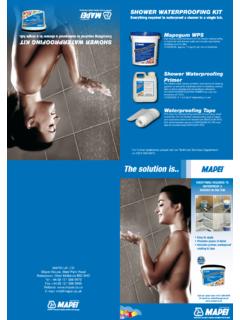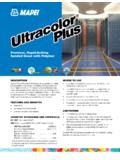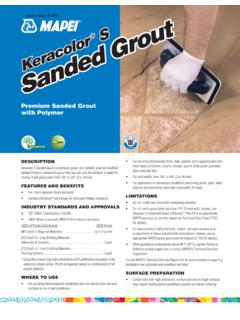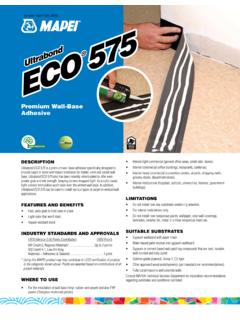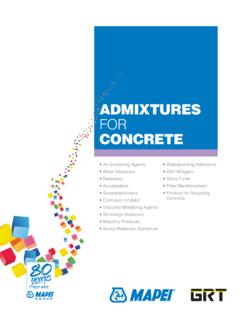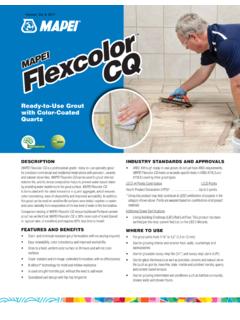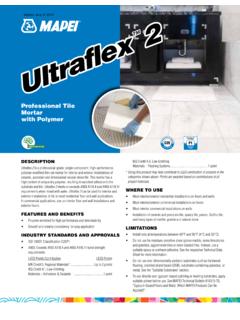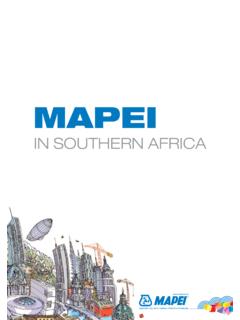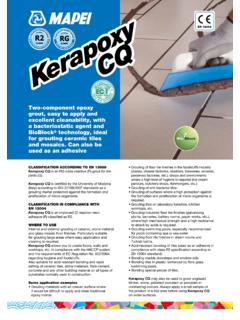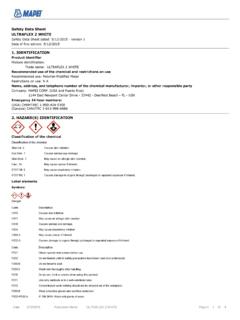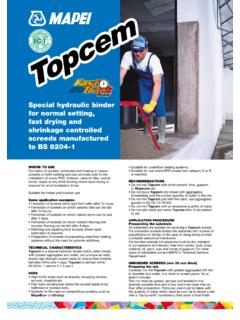Transcription of Special hydraulic binder for normal setting, fast ... - Mapei
1 WHERE TO USEF ormation of bonded, unbonded and floating screeds on both existing and new concrete prior to the installation of wood, PVC, linoleum, ceramic tiles, natural stone, carpet or any other flooring where rapid drying is required for short installation for indoor and outdoor application examples Formation of screeds set to light foot traffic after 12 hours and completely dry after 4 days, for laying resilient flooring and 4 days for wooden flooring. Formation of screeds on which ceramic tiles can be laid after 24 hours and natural stone after 2 days. Patching and repairing floor screeds where rapid restoration is required.
2 Preparation of screeds incorporating underfloor heating systems without the need for polymer CHARACTERISTICST opcem is a Special hydraulic binder which, when mixed with graded aggregates and water, can produce mortars that can harden in approximately 24 hours, and dry in approximately 4 Do not mix Topcem with other cement, lime, gypsum or Mapecem etc. Do not leave Topcem dry-mixed with aggregates, immediately add the correct quantity of water to the mix. Do not mix Topcem just with fine sand, use aggregates graded from 0 to 8 mm (for screeds up to 5-6 cm thick). Do not mix Topcem with an excessive quantity of water.
3 Do not add water and remix Topcem after it has started to PROCEDUREP reparating the substrateAll substrates are suitable for receiving a Topcem screed. Isolate the substrate with a sheet of polyethylene or similar; in the case of rising damp provide a suitable waterproof the screed is not of the self-bearing type, and the old cementitious, stone or ceramic substrate needs to be dry, resistant to compression and tension, free from cracks, dust, loose material, oil, paint, wax and traces of gypsum. For other types of substrates consult Mapei s Technical SCREEDS(35 to 60 mm thick) Preparing the mixCarefully mix the Topcem with graded aggregates 0-8 mm in diameter and water, in a mixer or batcher for at least 5 mix must be spread, tamped and levelled in the shortest possible time and in any event not more than an hour after preparation.
4 Particular care must be taken with the quantity of water which must be such as to obtain a mix with a damp earth consistency that under a float finish will compact to produce a closed and smooth surface without water hydraulic binder for normal setting, fast drying (4 days) and controlled shrinkage screedsTopcemTopcemOn compressible substrates Topcem screeds must be thick enough and should be reinforced with adequate steel DOSAGET opcem 200-250 kg/m Graded aggregates0-8 mm in diameter 1650-1800 kg/m Water 110-130 kg/m for dry aggregate. The amount of water could vary depending on the moisture in the aggregateor:Topcem one 20 kg bagGraded aggregates 0-8 mm in diameter 140-160 kgTopcem, aggregates and water can be mixed using: a drum mixer; an ordinary concrete mixer; a screw mixer; an automatic pressure manually with a shovel is not recommended as it does not permit good dispersion of the components of Topcem components resulting in the need to increase the quantity of water in order to obtain the right mix.
5 Where it is not possible to use a mechanical mixer and for small area that require mixing by hand, it is recommended to thoroughly dry mix the Topcem with the aggregates before adding the water in small amounts, turning the mix until a damp earth consistency is Topcem in a mini-batcherMixing Topcem with an automatic pumping unitBatching a Topcem mixTECHNICAL DATA (typical values)PRODUCT IDENTITYC onsistency:powderColour:greyBulk density (kg/m ):850 Dry solids content (%):100 EMICODE:EC1 R Plus - very low emissionAPPLICATION DATA (at +23 C - 50% )Mixing ratio:200-250 kg of Topcem with 1 m of aggregate (diameter from 0-8 mm) and 110-130 kg of water for dry aggregateDensity of the mix (kg/m ):2100 Mixing time:5-10 minutesWorking time of mix:60 minutesApplication temperature:from +5 C to +35 CSet to light foot traffic:after 12 hoursReady for use:4 daysApplication of levelling compound:after 1-4 daysWaiting time before installation:24 hours for ceramic tiles 2 days for stone material 4 days for resilients and woodResidual moisture after 4 days (%):< PERFORMANCE DATAR esistance to alkalis:excellentResistance to oils.
6 Excellent (poor to vegetable oils)Resistance to solvents:excellentTemperature when in use:from -30 C to +90 CTopcemTopcemscreed. Additionally reinforcing mesh should be placed over the underfloor heating may be commissioned after 4 THE MOISTURE CONTENTB ecause of the particular composition and character of Topcem, ordinary electric moisture meters, do not give reliable values; residual moisture can only be recorded with a carbide can be cleaned with varies in relation to the thickness of the screed and the dosage of doses of 200-250 kg of Topcem per m of aggregate consumption is kg/m /cm of kg paper can be stored for 12 months in a dry place in the original product complies with the conditions of Annex XVII to Regulation (EC) N 1907/2006 (REACH) - All.
7 XVII, item INSTRUCTIONS FOR PREPARATION AND INSTALLATIONT opcem contains cement that when in contact with sweat or other body fluids causes irritant alkaline reactions and allergic reactions to those predisposed. It can cause damage to eyes. It is recommended to use protective gloves and goggles and to take the usual precautions for handling chemicals. If the product comes in contact with the eyes or skin, wash immediately with plenty of water and seek medical attention. For further and complete information about the safe use of our product please refer to the latest version of our Material Safety Data FOR PROFESSIONAL the technical details and recommendations contained in this product data sheet correspond to the best of our knowledge and experience, all the above information must, in every case, be taken as merely indicative and subject to confirmation after long-term practical application; for this reason, anyone who intends to use the product must ensure beforehand that it is suitable for the envisaged application.
8 In every case, the user alone is fully responsible for any consequences deriving from the use of the refer to the current version of the Technical Data Sheet, available from our website 10-12 kg for dry aggregate. The amount of water could vary depending on the moisture in the aggregateSpreading the mixThe Topcem mix should be spread in the same way as a normal screed. A polyethylene isolating sheet (or other similar material) must be laid to create a separating layer between the screed and the supporting separating layer also provides the function of a vapour barrier, preventing damp rising from the substrate and also dehydration of the Topcem screed due to rapid absorption of water.
9 The absorbed water, rising subsequently would retard the drying screeds are prepared using the same techniques as for ordinary cement screeds, preparing levelling strips, laying the mix, carefully compacting it and then tamping for the required surface it is necessary to incorporate piping or sheathing in the Topcem screed the upper layer which must not be less than 2 cm thick, should be reinforced with galvanized steel mesh of not more than 30x30 the perimeter of the area and around columns etc., it is advisable to form an expansion joint about one centimetre wide between the wall and the screed with a flexible material (such as felt board, cork, polystyrene, etc.)
10 If the installation of the screed is interrupted away from a construction joint cut the day joint in the screed straight down and insert pieces of 3-6 mm diameter, steel rods 20-30 cm long, they should be spaced 20-30 cm apart to ensure perfect bonding and to avoid cracks and differing levels when work is average there is more time available for laying and working with Topcem screeds compared to traditional cement screeds. However the ambient temperature influences the setting and drying SCREEDS(10 to 35 mm thick)Preparing the mix, proportions and spreading the mix are exactly the same as for unbonded screeds, but first apply a Planicrete bonding slurry onto the perfectly clean OF THE BONDING SLURRYP lanicrete 1 part by weightWater 1 part by weightTopcem 3 parts by weightTo ensure adhesion, spread the slurry onto the surface to be covered immediately before the Topcem screed (fresh screed on fresh slurry).
